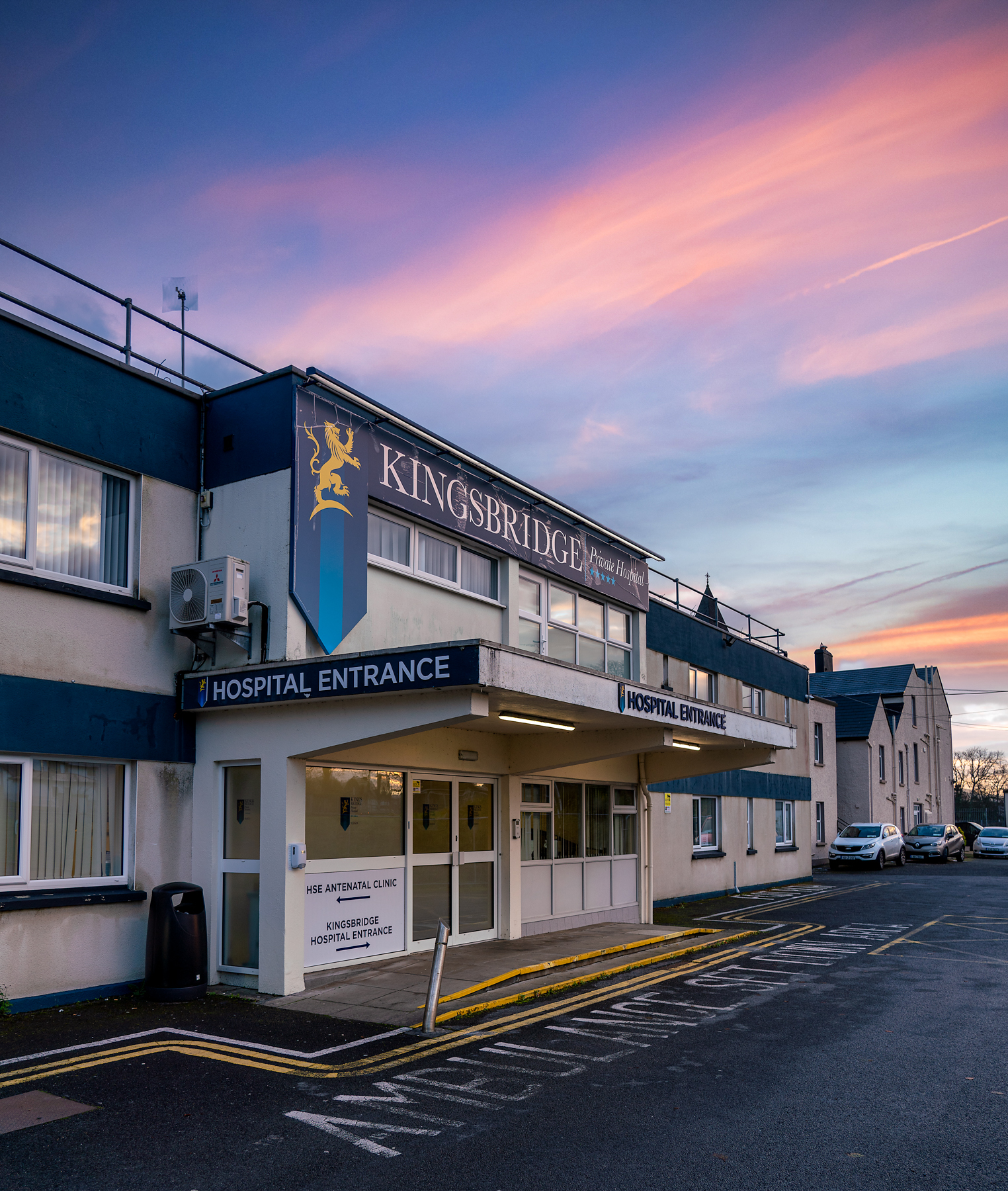Kingsbridge Private Hospital can support you through any gynaecological diagnosis that may require surgical intervention. We can facilitatea wide range of surgeries including day procedures and those that may require overnight stays.
Our surgeons and nurses are highly skilled in their field and you can be assured you are always in safe hands.
Some of the surgical procedures available at Kingsbridge Private Hospital include:
Hysterectomy
A Hysterectomy is an operation to remove the womb (uterus). It may be advised for a number of reasons including the removal of Fibroids. At Kingsbridge Private Hospital our expert consultants will provide you with any information or concerns you have before you decide to have a hysterectomy.
What is a hysterectomy ?
The female reproductive organs are made up of a womb, vagina, Fallopian tubes and ovaries. The womb is about the size of a pear. It is made of specialised muscle and lies in the pelvis between the bladder and the bowel. A Hysterectomy is the removal of the womb by an operation.
A hysterectomy can treat a number of conditions that affect the reproductive system including irregular or heavy menstrual bleeding, endometriosis, prolapse or fibroids.
A hysterectomy can be performed by one of the following three ways:
- An abdominal hysterectomy, where your womb is removed through a cut in your abdomen
- And a laparoscopic (keyhole) hysterectomy – a procedure done through small cuts in your abdomen which can also be used to assist with vaginal hysterectomy.
There are different types of surgeries which may be available depending on your condition:
- Supracervical hysterectomy—removal of the uterus only
- Total hysterectomy—removal of the uterus and cervix (the opening of the uterus leading to the vagina)
- Radical hysterectomy—removal of the uterus, ovaries, fallopian tubes, upper part of the vagina, and the pelvic lymph nodes
- Salpingo-oophorectomy—removal of the ovaries and fallopian tubes (may be combined with any of the above procedures)
Usually your ovaries are usually left in place because they produce oestrogen – otherwise you would immediately go through the menopause. After a hysterectomy, you will no longer have periods or be able to become pregnant.
Why would I have a hysterectomy?
You may have a hysterectomy if your uterus is causing health problems that cannot be treated by other means.
Possible reasons include the following:
- Heavy or very painful periods. In some women, day-to-day life is made difficult because of heavy periods. Sometimes the heavy bleeding can cause anaemia. There are various other treatment options for heavy periods, including tablets and an intrauterine system (Mirena® coil). If they do not help to improve the problem, hysterectomy is an option for treatment. See separate leaflet called 'Heavy Periods (Menorrhagia)' for further information.
- Fibroids. These are swellings of abnormal muscle that grow in the womb. Fibroids are common and often do not cause any symptoms. However, in some women they can cause heavy or painful periods. Some fibroids are quite large and can press on the bladder to cause urinary symptoms.
- Prolapse. This is where the uterus or parts of the vaginal wall drop down. This may happen after the menopause when the tissues which support the uterus tend to become thinner and weaker.
- Endometriosis. This is a condition where the cells which line the uterus are found outside the uterus in the pelvis. This can cause scarring around the uterus, and may cause the bladder or rectum to stick to the uterus or Fallopian tubes. Endometriosis may cause only mild symptoms, but some women develop painful periods, abdominal pain or have pain during sex.
- Cancer. Hysterectomy may be advised if you develop cancer of the cervix, uterus, Fallopian tubes or ovaries.
What happens during a vaginal hysterectomy?
Vaginal hysterectomy usually takes about an hour, during which your surgeon will pass specially designed instruments through your vagina to remove your cervix and womb. The surgeon will then close the top of your vagina using dissolvable stitches and may place a tampon-shaped dressing in your vagina. With a vaginal hysterectomy you won’t have any visible cuts or scars.
What happens during an abdominal hysterectomy?
An abdominal hysterectomy usually takes around an hour, but this can vary depending on the complexity of the surgery.
In most cases, your surgeon will create a 10cm long incision across your lower abdomen, just below your bikini line. Your surgeon will remove your womb through the cut in your abdomen, then stitches, metal clips or glue can be used to close the cut and the area will be covered with a dressing.
Following your hysterectomy
Recovery time will depend on the type of hysterectomy treatment you've received.
With a vaginal hysterectomy, you will need to stay in hospital for one to two days, whereas with an abdominal hysterectomy most women will stay in hospital for two to four days depending on recovery.
Following surgery at Kingsbridge Private Hospital it will usually take about four to six weeks to make a full recovery from a vaginal hysterectomy and most women are able to return to work between two and six weeks after the procedure.
An abdominal hysterectomy normally takes about 4 to 12 weeks to make a full recovery from. Most women find they are able to return to work between 4 and 8 weeks after the operation. During the recovery period you can lift light items, such as a kettle, but nothing heavy. Following surgery, we recommend that a friend or relative to stay with you for the first few days after your treatment.
Hysteroscopy
A Hysteroscopy is a procedure which uses small thin tube-like telescope to see inside the womb (uterus). It can also allow consultants to do some minor operations to the uterus.
What is a hysteroscopy?
Hysteroscopy is a procedure uses a narrow tube-like instrument called a hysteroscope to look inside the womb. The hysteroscope is very slim (about 3 to 5 millimetres in diameter). It's carefully passed through the vagina and neck of the uterus (cervix) and into your uterus. The hysteroscope has a video camera inside which sends pictures to a computer screen. This allows your consultant to check for any abnormalities in the lining of the uterus.
The hysteroscope has special channels which allow the consultant to pass various instruments into the uterus. This means that as well as being able to look inside the uterus, the consultant can perform certain procedures.
What is hysteroscopy used for?
A hysteroscopy may be used to try to determine the cause of various problems such as:
- Heavy or irregular bleeding that has not got better with medication.
- Bleeding in between your periods.
- Bleeding after your menopause.
- Irregular bleeding whilst you are taking hormone replacement therapy (HRT).
- If you are thinking about having an operation to make your periods less heavy (eg, endometrial ablation).
- Unexplained miscarriages.
A hysteroscopy may also be used to investigate the cause of various problems such as:
- Remove polyps - small lumps of tissue growing on the lining of the uterus.
- Remove scar tissue in the uterus.
- Remove adhesions (areas where the walls of the uterus are sticking together).
- Remove fibroids (non-cancerous growths in the uterus).
- Locate a 'lost' or stuck contraceptive device, such as an intrauterine contraceptive device (IUCD) - also known as a 'coil'.
Before you have the procedure your consultant at Kingsbridge Private Hospital will talk to you about the test and discuss a number of different treatment options with you. For some symptoms it may be possible to treat them immediately, using a hysteroscope. Your consultant will advise you on the best course of treatment at your appointment.
Oophorectomy
Oophorectomy is the surgical removal of an ovary. If one ovary is removed, a woman may continue to menstruate and have children but if both ovaries are removed, menstruation stops and a woman loses the ability to have children.
Unilateral oophorectomy (also called an ovariectomy) is the surgical removal of an ovary.
If one ovary is removed, a woman may continue to menstruate and have children but if both ovaries are removed (bilateral oophorectomy), menstruation stops and a woman loses the ability to have children.
Oophorectomy is often performed to:
- remove cancerous ovaries
- remove the source of estrogen that stimulates some cancers
- remove a large ovarian cyst
- excise an abscess
- treat endometriosis
In an oophorectomy, one or part of an ovary may be removed or both ovaries may be removed.
When an oophorectomy is done to treat ovarian cancer or other spreading cancers, both ovaries are removed (called a bilateral oophorectomy).
Removal of the ovaries and fallopian tubes is performed in about one-third of hysterectomies (surgical removal of the uterus), often to minimise the risk of ovarian cancer.
Oophorectomies are sometimes performed on premenopausal women who have estrogen-sensitive breast cancer in an effort to remove the main source of estrogen from their bodies although this procedure has become less common.
At Kingsbridge Private Hospital our Consultants will be able to advise you on the best form of treatment. In some cases surgery may not be needed and alternative treatments will be offered.
Laparoscopically Assisted Vaginal Hysterectomy (LAVH)
Total laparoscopic hysterectomy is a keyhole hysterectomy done through tiny cuts in the tummy, using tiny, modern cutting instruments to diminish the damage to the skin and the pelvic tissues. Keyhole surgery has many advantages to open surgery.
Benefits of a total laparoscopic hysterectomy?
Trauma to the skin and the tissues in the pelvis is smaller and this means that recovery is much quicker than after a tummy cut (laparotomy). The average hospital stay is 1-2 days only and the majority of patients resume their normal activities quickly. That can be an important factor for those looking after their children, needing to go back to work and those who would like to enjoy their full, active life as soon as possible.
The benefits of keyhole surgery are:
- Shorter hospital day (1-2 days)
- Faster recovery back to normal (2-3 weeks sick leave only)
- Less blood loss during the operation
- Less risk of wound infection and breakdown
- Minimal scarring
Hysterectomy is commonly advised for people suffering from:
- Heavy periods (where other conservative methods failed)
- Fibroids
- Endometriosis
- Chronic pelvic inflammation
- Prolapse
- Cancer of the uterus, cervix or ovary
- Precancerous changes of cervix or uterus







